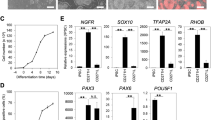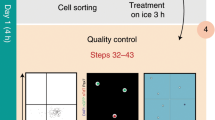Abstract
Human embryonic stem cells (hESCs) are a promising source for cell therapy in degenerative diseases. A key step in establishing the medical potential of hESCs is the development of techniques for the conversion of hESCs into tissue-restricted precursors suitable for transplantation. We recently described the derivation of multipotent mesenchymal precursors from hESCs. Nevertheless, our previous study was limited by the requirement for mouse feeders and the lack of in vivo data. Here we report a stroma-free induction system for deriving mesenchymal precursors. Selective culture conditions and fluorescence-activated cell sorting (FACS)-mediated purification yielded multipotent mesenchymal precursors and skeletal myoblasts. Skeletal muscle cells undergo in vitro maturation resulting in myotube formation and spontaneous twitching. We found that hESC-derived skeletal myoblasts were viable after transplantation into the tibialis anterior muscle of SCID/Beige mice, as assessed by bioluminescence imaging. Lack of teratoma formation and evidence of long-term myoblast engraftment suggests considerable potential for future therapeutic applications.
This is a preview of subscription content, access via your institution
Access options
Subscribe to this journal
Receive 12 print issues and online access
$209.00 per year
only $17.42 per issue
Buy this article
- Purchase on Springer Link
- Instant access to full article PDF
Prices may be subject to local taxes which are calculated during checkout





Similar content being viewed by others
Accession codes
References
Trounson, A. The production and directed differentiation of human embryonic stem cells. Endocr. Rev. 27, 208–219 (2006).
Barberi, T., Willis, L., Socci, N.D. & Studer, L. Derivation of multipotent mesenchymal precursors from human embryonic stem cells. PLoS Med. 2, e161 (2005).
Nakano, T., Kodama, H. & Honjo, T. Generation of lymphohematopoietic cells from embryonic stem cells in culture. Science 265, 1098–1101 (1994).
Walsh, F.S. & Ritter, M.A. Surface antigen differentiation during human myogenesis in culture. Nature 289, 60–64 (1981).
Okabe, S., Forsberg-Nilsson, K., Spiro, A.C., Segal, M. & McKay, R.D.G. Development of neuronal precursor cells and functional postmitotic neurons from embryonic stem cells in vitro. Mech. Dev. 59, 89–102 (1996).
Gronthos, S. et al. Molecular and cellular characterisation of highly purified stromal stem cells derived from human bone marrow. J. Cell Sci. 116, 1827–1835 (2003).
Maitra, A. et al. Genomic alterations in cultured human embryonic stem cells. Nat. Genet. 37, 1099–1103 (2005).
Litvinov, S.V., Velders, M.P., Bakker, H.A., Fleuren, G.J. & Warnaar, S.O. Ep-CAM: a human epithelial antigen is a homophilic cell-cell adhesion molecule. J. Cell Biol. 125, 437–446 (1994).
Lanctot, C., Lamolet, B. & Drouin, J. The bicoid-related homeoprotein Ptx1 defines the most anterior domain of the embryo and differentiates posterior from anterior lateral mesoderm. Development 124, 2807–2817 (1997).
Chapman, D.L., Agulnik, I., Hancock, S., Silver, L.M. & Papaioannou, V.E. Tbx6, a mouse T-Box gene implicated in paraxial mesoderm formation at gastrulation. Dev. Biol. 180, 534–542 (1996).
Minguillon, C., Del, B.J. & Logan, M.P. Tbx5 and Tbx4 are not sufficient to determine limb-specific morphologies but have common roles in initiating limb outgrowth. Dev. Cell 8, 75–84 (2005).
Saito, D., Yonei-Tamura, S., Takahashi, Y. & Tamura, K. Level-specific role of paraxial mesoderm in regulation of Tbx5/Tbx4 expression and limb initiation. Dev. Biol. 292, 79–89 (2006).
Cusella De Angelis, M.G. et al. Skeletal myogenic progenitors in the endothelium of lung and yolk sac. Exp. Cell Res. 290, 207–216 (2003).
Xu, K., Ma, H., McCown, T.J., Verma, I.M. & Kafri, T. Generation of a stable cell line producing high-titer self-inactivating lentiviral vectors. Mol. Ther. 3, 97–104 (2001).
Xu, C. et al. Immortalized fibroblast-like cells derived from human embryonic stem cells support undifferentiated cell growth. Stem Cells 22, 972–980 (2004).
Kubo, A. et al. Development of definitive endoderm from embryonic stem cells in culture. Development 131, 1651–1662 (2004).
Tada, S. et al. Characterization of mesendoderm: a diverging point of the definitive endoderm and mesoderm in embryonic stem cell differentiation culture. Development 132, 4363–4374 (2005).
Yaffe, D. & Saxel, O. A myogenic cell line with altered serum requirements for differentiation. Differentiation 7, 159–166 (1977).
Seale, P. et al. Pax7 is required for the specification of myogenic satellite cells. Cell 102, 777–786 (2000).
Sampaolesi, M. et al. Cell therapy of alpha-sarcoglycan null dystrophic mice through intra-arterial delivery of mesoangioblasts. Science 301, 487–492 (2003).
Dezawa, M. et al. Bone marrow stromal cells generate muscle cells and repair muscle degeneration. Science 309, 314–317 (2005).
Guettier-Sigrist, S., Coupin, G., Warter, J.M. & Poindron, P. Cell types required to efficiently innervate human muscle cells in vitro. Exp. Cell Res. 259, 204–212 (2000).
Zhang, S.C., Wernig, M., Duncan, I.D., Brustle, O. & Thomson, J.A. In vitro differentiation of transplantable neural precursors from human embryonic stem cells. Nat. Biotechnol. 19, 1129–1133 (2001).
Pittenger, M.F. et al. Multilineage potential of adult human mesenchymal stem cells. Science 284, 143–147 (1999).
Smyth, G.K. Linear models and empirical Bayes methods for assessing differential expression in microarray experiments. Stat. Appl. Genet. Mol. Biol. [online] 3, 3 (2004).
Acknowledgements
We thank S. Clairmont, J. Vider and G. Al Shamy for technical assistance, S. Desbordes (Memorial Sloan-Kettering Cancer Center, MSKCC) for providing reagents for the study, V. Ponomarev (MSKCC) for the TGL vector, and V. Tabar for advice on the in vivo studies. The work was supported in part through a nonrestricted grant from the Kinetics Foundation and by the ALS Association and Project ALS.
Author information
Authors and Affiliations
Contributions
T.B. and L.S. designed the study, developed in vitro differentiation protocols, participated in data analysis, and wrote the manuscript; M.B. conducted the imaging studies; Z.D. contributed to both in vitro and in vivo studies and performed histological analyses; G.P. was responsible for muscle lesioning and transplantation; N.D.S. carried out analysis of the microrarray data.
Corresponding authors
Ethics declarations
Competing interests
The authors declare no competing financial interests.
Supplementary information
Supplementary Fig. 1
Chondrocytic differentiation of hESC-derived mesenchymal precursors. (PDF 66 kb)
Supplementary Fig. 2
Analysis of hESC-derived CD73− and CD73+ progeny. (PDF 111 kb)
Supplementary Fig. 3
BLI signal and histological analysis in animals grafted with hESC-derived myocytes at various time points after cardiotoxin exposure. (PDF 1173 kb)
Supplementary Fig. 4
Schematic representation of the stroma-free differentiation system. Time course and details are given for the sequential steps leading to the isolation of first mesenchymal precursors and then specific mesenchymal derivatives (further details in Methods). (PDF 2384 kb)
Supplementary Table 1
Primer sequences, cycle numbers, and annealing temperatures for the RT-PCR analyses performed in the current study. (PDF 45 kb)
Supplementary Video 1
Movie showing spontaneous contraction of mature myocytes and early myotubes in culture of hESC-derived skeletal muscle cells (SF2) after 3 weeks of N2 exposure. (AVI 567 kb)
Rights and permissions
About this article
Cite this article
Barberi, T., Bradbury, M., Dincer, Z. et al. Derivation of engraftable skeletal myoblasts from human embryonic stem cells. Nat Med 13, 642–648 (2007). https://doi.org/10.1038/nm1533
Received:
Accepted:
Published:
Issue Date:
DOI: https://doi.org/10.1038/nm1533
This article is cited by
-
Stem cell-based strategies and challenges for production of cultivated meat
Nature Food (2023)
-
Control of satellite cell function in muscle regeneration and its disruption in ageing
Nature Reviews Molecular Cell Biology (2022)
-
Generation of human myogenic progenitors from pluripotent stem cells for in vivo regeneration
Cellular and Molecular Life Sciences (2022)
-
Restoration of dystrophin expression in mice by suppressing a nonsense mutation through the incorporation of unnatural amino acids
Nature Biomedical Engineering (2021)
-
Approaches to characterize the transcriptional trajectory of human myogenesis
Cellular and Molecular Life Sciences (2021)



